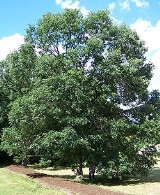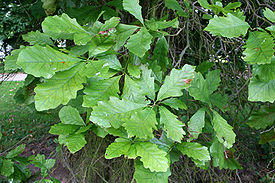
Swamp White Oak
Encyclopedia
Quercus bicolor, the swamp white oak, is a medium-sized tree of the north central and northeastern mixed forests. It has a very large range, and can survive in a variety of habitats. It grows rapidly and can reach 300 to 350 years. It is not a large tree, typically growing to 20-25m (65–80 ft) tall, with the tallest known reaching 29 m (95 ft).
It forms hybrids with Bur Oak
where they occur together in the wild.

resembles the White Oak. The leaves
are broad ovoid, 12–18 cm (4–7 in) long and 7-11 (3–4 in) cm broad, always more or less glaucous on the underside, and are shallowly lobed with five to seven lobes on each side, intermediate between the Chestnut Oak
and the White Oak
. In autumn, they turn brown, yellow-brown, or sometimes reddish, but generally, the color is not as reliable or as brilliant as the White Oak
can be. The fruit
is a peduncled acorn
, 1.5–2 cm (rarely 2.5 cm) (.6-.8 in, rarely 1 in) long and 1–2 cm (.4-.8 in) broad, maturing about 6 months after pollination.
The swamp white oak typically grows on hydromorphic soils. It is not found where flooding is permanent, although it is usually found in broad stream valleys, low-lying fields, and the margins of lakes, ponds, or sloughs.
production. In recent years, the swamp white oak has become a popular landscaping tree, partly due to its relative ease of transplanting.
The New York Times has reported that over 400 Swamp White Oak trees are being planted in the newly constructed September 11 Memorial Plaza in Manhattan.
It forms hybrids with Bur Oak
Bur oak
Quercus macrocarpa, the Bur Oak, sometimes spelled Burr Oak, is a species of oak in the white oak section Quercus sect. Quercus, native to North America in the eastern and midwestern United States and south-central Canada...
where they occur together in the wild.

Description
The barkBark
Bark is the outermost layers of stems and roots of woody plants. Plants with bark include trees, woody vines and shrubs. Bark refers to all the tissues outside of the vascular cambium and is a nontechnical term. It overlays the wood and consists of the inner bark and the outer bark. The inner...
resembles the White Oak. The leaves
Leaf
A leaf is an organ of a vascular plant, as defined in botanical terms, and in particular in plant morphology. Foliage is a mass noun that refers to leaves as a feature of plants....
are broad ovoid, 12–18 cm (4–7 in) long and 7-11 (3–4 in) cm broad, always more or less glaucous on the underside, and are shallowly lobed with five to seven lobes on each side, intermediate between the Chestnut Oak
Chestnut oak
Quercus prinus , the chestnut oak, is a species of oak in the white oak group, Quercus sect. Quercus. It is native to the eastern United States, where it is one of the most important ridgetop trees from southern Maine southwest to central Mississippi, with an outlying northwestern population in...
and the White Oak
White Oak
White Oak may refer to:* Quercus alba, a species commonly known as the White Oak* any of various trees from the botanical section Quercus within the list of Quercus species* a 1921 silent western written/produced by and starring William S...
. In autumn, they turn brown, yellow-brown, or sometimes reddish, but generally, the color is not as reliable or as brilliant as the White Oak
White Oak
White Oak may refer to:* Quercus alba, a species commonly known as the White Oak* any of various trees from the botanical section Quercus within the list of Quercus species* a 1921 silent western written/produced by and starring William S...
can be. The fruit
Fruit
In broad terms, a fruit is a structure of a plant that contains its seeds.The term has different meanings dependent on context. In non-technical usage, such as food preparation, fruit normally means the fleshy seed-associated structures of certain plants that are sweet and edible in the raw state,...
is a peduncled acorn
Acorn
The acorn, or oak nut, is the nut of the oaks and their close relatives . It usually contains a single seed , enclosed in a tough, leathery shell, and borne in a cup-shaped cupule. Acorns vary from 1–6 cm long and 0.8–4 cm broad...
, 1.5–2 cm (rarely 2.5 cm) (.6-.8 in, rarely 1 in) long and 1–2 cm (.4-.8 in) broad, maturing about 6 months after pollination.
Habitat
The swamp white oak generally occurs singly in four different forest types: Black Ash-American Elm-Red Maple, Silver Maple-American Elm, Bur Oak, and Pin Oak-Sweetgum. Occasionally the swamp white oak is abundant in small areas. It is found within a very wide range of mean annual temperatures from 16°C (60°F) to 4°C (40°F). Extremes in temperature vary from 41°C (105°F) to -34°C (-30°F). Average annual precipitation is from 640 mm (25 in) to 1270 mm (50 in). The frost-free period ranges from 210 days in the southern part of the growing area to 120 days in the northern part.The swamp white oak typically grows on hydromorphic soils. It is not found where flooding is permanent, although it is usually found in broad stream valleys, low-lying fields, and the margins of lakes, ponds, or sloughs.
Range
Swamp white oak, a lowland tree, grows from southwestern Maine west to New York, southern Quebec, and southern Ontario, to central Michigan, northern Wisconsin, and southeastern Minnesota; south to Iowa and Missouri; east to Kentucky, Tennessee, Virginia, and New Jersey. It is scattered in North Carolina and northeastern Kansas. This species is most common and reaches its largest size in western New York and northern Ohio.Cultivation and uses
It is one of the more important white oaks for lumberLumber
Lumber or timber is wood in any of its stages from felling through readiness for use as structural material for construction, or wood pulp for paper production....
production. In recent years, the swamp white oak has become a popular landscaping tree, partly due to its relative ease of transplanting.
The New York Times has reported that over 400 Swamp White Oak trees are being planted in the newly constructed September 11 Memorial Plaza in Manhattan.

